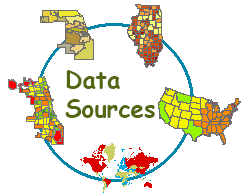I am often asked, ‘where can I find good data for my research?’ which prompted me to put together a list of good data sources for both geospatial and non-geospatial data.
Geography: Chicago
Description: The City of Chicago Data Portal includes more than 250 datasets, both spatial and non-spatial, organized into 16 different categories ranging from transportation and sanitation to education and economic development. Users can visualize the data as maps, graphs and charts, by specifying filtering criteria. Experienced users can download the information as datasets in various formats for further analysis.
URL: https://data.cityofchicago.org/
Geography: Cook County
Description: Similar to the Chicago’s data portal, the Cook County Open Portal also has an extensive collection of geospatial and non-geospatial datasets. The data is organized into 8 main categories such as courts, economic development, finance and administration, forest preserves, health care, public safety, property tax and GIS/Maps. Users can download the data into various formats or visualize it within the portal, even embedding the visuals into their own sites.
URL: https://datacatalog.cookcountyil.gov/
Geography: Illinois
Description: The University of Illinois Springfield has compiled a list of data sources related to Illinois and the United States, grouped by 5 different topics, and including both spatial and non-spatial data.
URL: http://www.uis.edu/gis/projects/data/
Geography: USA
Description:
(1) U.S. Census is the first place to go for data related to population or housing. It provides new census data every 10 years and annual data from the American Community Survey in between its decennial censuses. Two decades of both spatial and non-spatial data are available concerning demographic, socio-economic and housing characteristics for various geographic extents and units of analysis. The information can be downloaded as raw data files or as summary tables, and sometimes as maps.
URL: http://factfinder.census.gov/faces/nav/jsf/pages/index.xhtml (Raw Data)
http://www.census.gov/geo/maps-data/ (All other)
(2) Data.gov is the U.S. Government’s open data portal for federal, state and local data including tools and resources to conduct research and design data visualizations. The data is grouped into 14 main industries ranging from agriculture, manufacturing and energy to education, consumer and government. The data comes from hundreds of organizations, including federal and non-federal government agencies.
(3) The Pew Research Center’s data site consists of a multitude of key national, political, economic and demographic trends gathered over time on issues, attitudes and trends for the U.S. and also world polling/survey data.
URL: http://www.pewresearch.org/data/download-datasets/
http://www.pewresearch.org/data/ (Indicators)
Geography: World
Description:
(1) The World Bank’s open data site consists of datasets, databases, pre-formatted tables, reports and other resources aggregated by countries, regions or sub-regions over multiple decades. Similar to other data portals, this site also lets users download data, filter it by criteria and/or visualize it.
URL: http://databank.worldbank.org/data/databases.aspx
http://datacatalog.worldbank.org/ (Catalog)
http://data.worldbank.org/ (Reports)
(2) The UN has more than 60 million datasets spanning decades and covering a wide range of topics including agriculture, crime, education, employment, energy, environment, health, HIV/AIDS, human development, industry, population, refugees, tourism and trade, to name just some. The site not only allows downloading data based on filtering criteria, but also provides easy access to country profiles.
URL: http://data.un.org/Explorer.aspx
(3) GISGeography.com put together a list of 10 free, downloadable, geospatial data sources for global data from various reputable sources. The link shows a list of sites, their advantages and categories by data types.
URL: http://gisgeography.com/best-free-gis-data-sources-raster-vector/
Where else can you find good data?







